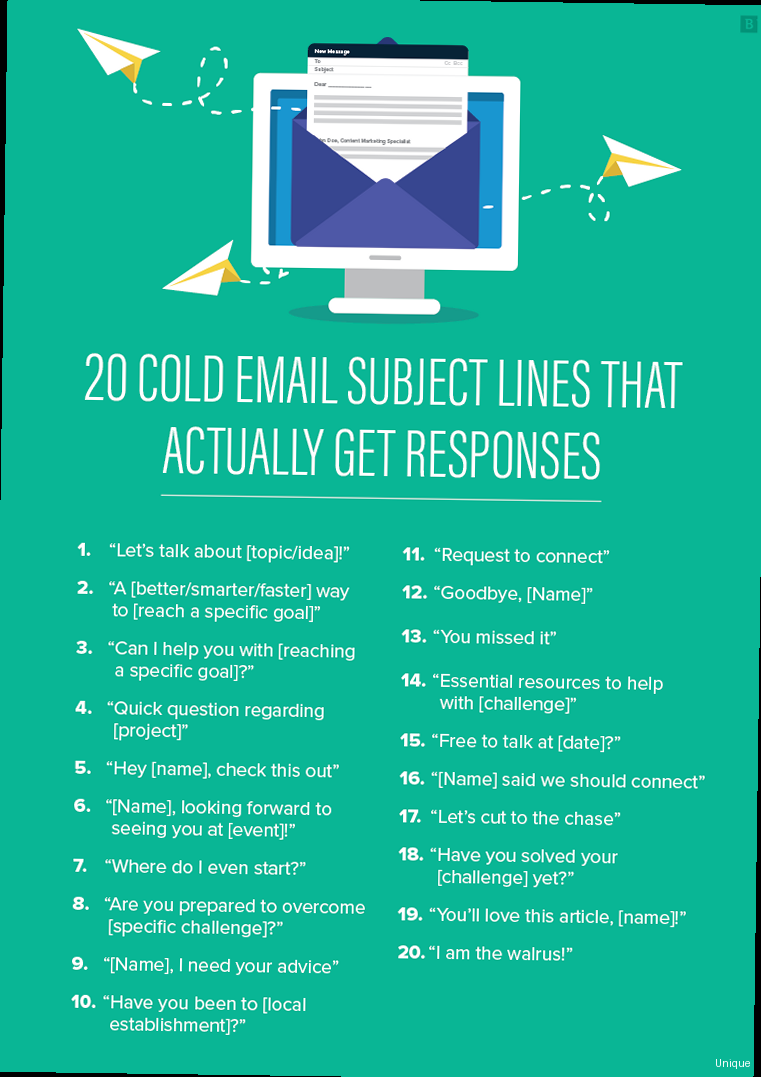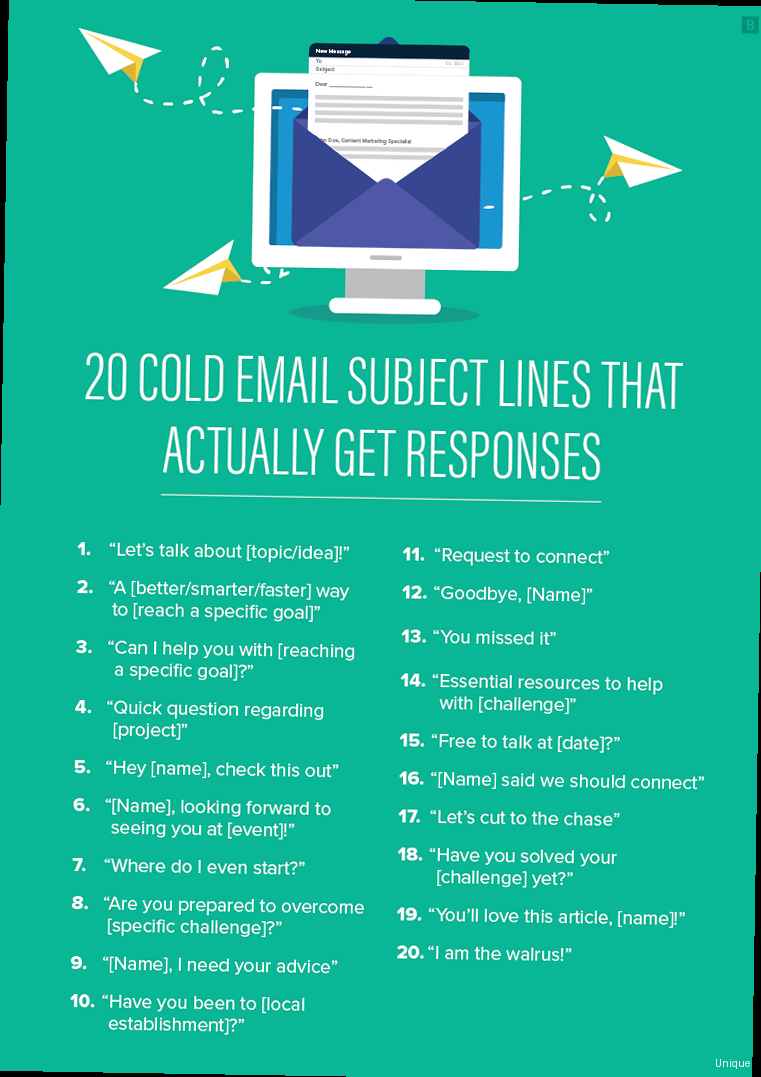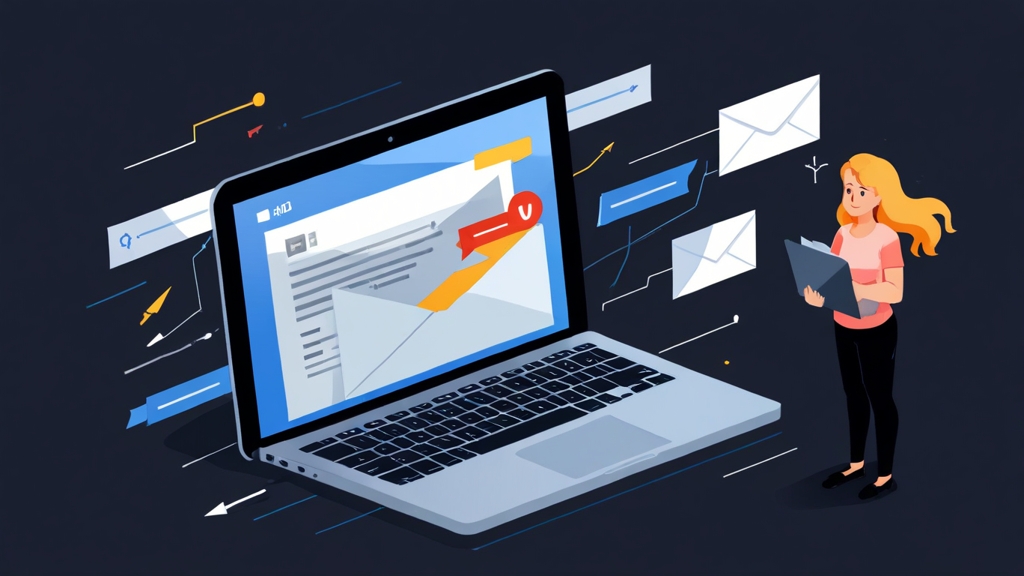Top Subject Lines for Cold Emails: A Practical Guide
Crafting the perfect cold email subject line is an art. It’s the gatekeeper to your message, the first (and sometimes only) impression you make. A compelling subject line can significantly boost your open rates, turning a cold outreach into a warm conversation. This guide provides actionable strategies and real-world examples to help you create subject lines that grab attention and drive engagement.
Table of Contents:
- Personalization: Making it About Them
- Creating Curiosity: The Intrigue Factor
- Highlighting Value: What’s in it for Them?
- Sense of Urgency: Acting Now
- Avoiding the Spam Folder: Best Practices
Personalization: Making it About Them

Congrats on the Social Media Award, [First Name]![Mutual Connection Name] suggested I reach out, [First Name]Fellow [Industry Group] member, [First Name] - a question for you[Company Name]'s website speed - a quick fix?Expert Tip: Use a CRM or email marketing platform that allows you to dynamically insert personalized fields into your subject lines. This will save you time and ensure accuracy. Be sure to double-check your data before sending out emails to avoid embarrassing errors.“People ignore design that ignores people.” – Frank Chimero
Creating Curiosity: The Intrigue Factor

Struggling with [Specific Problem]?What if you could [Desired Outcome]?[Shocking Statistic] in [Industry] - are you prepared?Unlock [Desired Benefit] for your companyA faster way to [Achieve Desired Outcome]Highlighting Value: What’s in it for Them?
Ultimately, people open emails because they believe there’s something valuable inside. Your subject line should clearly communicate the value you’re offering, whether it’s a solution to a problem, a time-saving tool, or an opportunity for growth. This is especially crucial for cold emails, where you need to quickly grab attention and convince the recipient that your message is worth their time. The key is to focus on the benefits, not just the features, of your product or service. What problem do you solve? How do you make their lives easier? Remember, people are inherently self-interested. They want to know what’s in it for them. By clearly articulating the value proposition in your subject line, you increase the likelihood that they’ll open your email and consider your offer. Focusing on the Benefits, Not Features A common mistake is to focus on the features of your product or service in the subject line. Features are simply the components of what you offer; benefits are the positive outcomes that result from using your product or service. Focus on the latter. For example, instead of saying “Our software has advanced AI capabilities,” say “Automate your marketing and save 10 hours per week.” The first subject line highlights a feature (AI capabilities), while the second highlights a benefit (saving time). Example 1: Highlighting Time Savings Time is a precious commodity for busy professionals. If your product or service can save them time, highlight that in your subject line.Save 5 hours a week on [Task] with our solutionIncrease your [Metric] by [Percentage] with our [Solution]Solve your [Problem] problem once and for allSense of Urgency: Acting Now
Creating a sense of urgency can be a powerful way to motivate people to open your email and take action. Urgency taps into the fear of missing out (FOMO) and encourages recipients to act quickly. However, it’s crucial to use urgency ethically and avoid creating false or misleading claims. The key is to create genuine urgency by offering limited-time deals, deadlines, or exclusive opportunities. Using urgency inappropriately can damage your credibility and make your email seem spammy. The human brain is wired to respond to scarcity and deadlines. When we perceive something as being limited or available for a short time only, we’re more likely to take action. This principle can be effectively applied to cold email subject lines. Creating Genuine Urgency, Not False Scarcity Avoid using false or misleading urgency tactics, such as claiming that a product is “almost sold out” when it’s not, or setting a deadline that you don’t intend to enforce. These tactics can backfire and damage your reputation. Focus on creating genuine urgency by offering limited-time deals or exclusive opportunities. For example, instead of saying “Limited time offer!” without any further details, try “Free trial ends this Friday – don’t miss out!” The second subject line provides a specific deadline and a clear reason to act quickly. Example 1: Highlighting a Limited-Time Offer Offering a discount or bonus for a limited time can be a great way to create urgency.[Discount Percentage]% off until [Date]Limited-time offer: Get a free [Bonus] with your purchaseDeadline approaching: Register for our webinar by [Date]Only [Number] spots left for our [Program/Service]Avoiding the Spam Folder: Best Practices
No matter how compelling your subject line is, it won’t matter if your email ends up in the spam folder. Email providers use sophisticated algorithms to identify and filter out spam, and certain words and phrases are more likely to trigger these filters than others. It’s crucial to avoid using these “spam trigger words” and follow best practices to ensure your emails reach the inbox. Maintaining a good sender reputation is also vital for deliverability. This involves ensuring your emails are properly authenticated (SPF, DKIM, DMARC), that you have a low bounce rate, and that recipients aren’t marking your emails as spam. Think of email providers as gatekeepers. They’re constantly evaluating incoming emails to determine whether they’re legitimate and valuable or spam. If your email raises red flags, it’s likely to be blocked or sent to the spam folder. Common Spam Trigger Words to Avoid Certain words and phrases are commonly associated with spam and are more likely to trigger spam filters. Here are some examples to avoid in your subject lines:- Free
- Guaranteed
- Discount
- Offer
- Act now
- Limited time
- Click here
- Amazing
- Incredible
- Best price
- 100% satisfaction
- Earn money
- Work from home
- Cash
- Debt
- Use a reputable email marketing platform: Platforms like Mailchimp, Sendinblue, and HubSpot have built-in features to help improve deliverability.
- Authenticate your emails: Set up SPF, DKIM, and DMARC records to verify that you are the legitimate sender of your emails. This helps to prevent spoofing and phishing.
- Maintain a clean email list: Regularly remove inactive or invalid email addresses from your list to reduce your bounce rate.
- Avoid using all caps or excessive exclamation points: These can make your email seem spammy.
- Test your emails before sending them: Use a spam checker tool to identify any potential issues with your subject line or content.
- Provide a clear unsubscribe link: Make it easy for recipients to unsubscribe from your emails if they no longer want to receive them.
- Monitor your sender reputation: Use tools like Google Postmaster Tools to track your sender reputation and identify any potential problems.
v=spf1 mx include:sendinblue.com ~allv=spf1: Specifies the SPF version.mx: Authorizes the mail servers listed in your MX records to send email on behalf of your domain.include:sendinblue.com: Authorizes Sendinblue’s mail servers to send email on behalf of your domain (replace with your email provider’s domain).~all: Specifies that any email not sent from an authorized mail server should be treated as a soft fail (accepted but marked as suspicious).
- Spam rate
- IP reputation
- Domain reputation
- Feedback loop
- Authentication
- Encryption
| Best Practice | Why It Matters |
|---|---|
| Authentication (SPF, DKIM, DMARC) | Verifies your identity and prevents spoofing. |
| Clean Email List | Reduces bounce rates and improves sender reputation. |
| Avoid Spam Trigger Words | Prevents emails from being flagged as spam. |
| Monitor Sender Reputation | Allows you to identify and address deliverability issues. |
